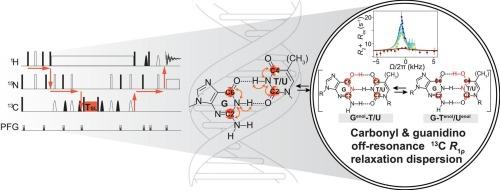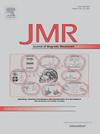利用非共振羰基和鸟嘌呤碳R1ρ弛豫色散探测核酸的稀有和短寿命构象态
IF 1.9
3区 化学
Q3 BIOCHEMICAL RESEARCH METHODS
引用次数: 0
摘要
基于化学交换的核磁共振技术为表征核酸中低密度和短寿命的构象状态提供了强有力的方法。在可能的探针中,核碱基羰基和胍基碳因其化学转变对氢键和酮-烯醇互变异构的敏感性而脱颖而出。然而,针对这些碳核的化学交换测量尚未在核酸研究中报道。在这里,我们提出了一个实验测量非共振R1ρ弛豫色散的鸟嘌呤- c2,鸟嘌呤- c6,胸腺嘧啶/尿嘧啶- c2和胸腺嘧啶/尿嘧啶- c4碳在均匀13C/15N标记的核酸。我们通过表征双工DNA中G•T不匹配的化学交换,在一个主要的摆动构象和两个低密度的、短寿命的、快速相互转换的沃森-克里克样互变异构态(Genol•T + G•Tenol)之间进行了实验,证明了该实验的效用。从鸟嘌呤- c6、鸟嘌呤- c2和胸腺嘧啶- c4非共振R1ρ弛豫色散谱中得到的居群和交换率与质子结合碳核和氮核的R1ρ测量结果非常吻合。次要态的碳化学位移相对于摆动基态向下移动,与(G)C6 = O··O-C4(Tenol)和(Genol)C6- oh··O=C4(T)在沃森-克里克样互变异构态中的氢键一致。作为第二个应用,我们没有检测到任何交换对uracil-C2和uracil-C4 R1ρ谱的贡献,用于测量RNA中的U·U错配,这与发生在亚微秒时间尺度上的两种可选摆动构象之间的异构化一致。这些结果建立了羰基和胍基碳作为有价值的探针的化学交换测量的微至毫秒运动的核酸。本文章由计算机程序翻译,如有差异,请以英文原文为准。

Probing rare and short-lived conformational states in nucleic acids using off-resonance carbonyl and guanidino carbon R1ρ relaxation dispersion
Chemical exchange-based NMR techniques provide powerful approaches for characterizing lowly-populated and short-lived conformational states in nucleic acids. Among possible probes, the nucleobase carbonyl and guanidino carbons stand out due to the sensitivity of their chemical shifts to hydrogen bonding and keto–enol tautomerization. However, chemical exchange measurements targeting these carbon nuclei have not yet been reported in studies of nucleic acids. Here, we present an experiment for measuring off-resonance R1ρ relaxation dispersion for guanine-C2, guanine-C6, thymine/uracil-C2, and thymine/uracil-C4 carbons in uniformly 13C/15N labeled nucleic acids. We demonstrate the utility of the experiment by characterizing chemical exchange in a G•T mismatch in duplex DNA between a dominant wobble conformation and two lowly-populated, short-lived, and rapidly interconverting Watson–Crick-like tautomeric states (Genol•T ⇌ G•Tenol) implicated in DNA replicative errors. The population and exchange rate deduced from the guanine-C6, guanine-C2, and thymine-C4 off-resonance R1ρ relaxation dispersion profiles were in excellent agreement with counterparts obtained from R1ρ measurements on proton-bound carbon and nitrogen nuclei. The carbon chemical shifts of the minor state were downfield shifted relative to the wobble ground state, consistent with (G)C6 = O···HO-C4(Tenol) and (Genol)C6-OH···O=C4(T) hydrogen bonding in the Watson-Crick-like tautomeric state. As a second application, we did not detect any exchange contribution to uracil-C2 and uracil-C4 R1ρ profiles measured for a U·U mismatch in RNA, consistent with isomerization between two alternative wobble conformations occurring on the sub-microsecond timescale. These results establish carbonyl and guanidino carbons as valuable probes for chemical exchange measurements of micro-to-millisecond motions in nucleic acids.
求助全文
通过发布文献求助,成功后即可免费获取论文全文。
去求助
来源期刊
CiteScore
3.80
自引率
13.60%
发文量
150
审稿时长
69 days
期刊介绍:
The Journal of Magnetic Resonance presents original technical and scientific papers in all aspects of magnetic resonance, including nuclear magnetic resonance spectroscopy (NMR) of solids and liquids, electron spin/paramagnetic resonance (EPR), in vivo magnetic resonance imaging (MRI) and spectroscopy (MRS), nuclear quadrupole resonance (NQR) and magnetic resonance phenomena at nearly zero fields or in combination with optics. The Journal''s main aims include deepening the physical principles underlying all these spectroscopies, publishing significant theoretical and experimental results leading to spectral and spatial progress in these areas, and opening new MR-based applications in chemistry, biology and medicine. The Journal also seeks descriptions of novel apparatuses, new experimental protocols, and new procedures of data analysis and interpretation - including computational and quantum-mechanical methods - capable of advancing MR spectroscopy and imaging.

 求助内容:
求助内容: 应助结果提醒方式:
应助结果提醒方式:


